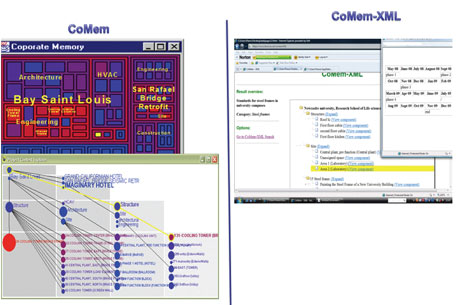by Peter Demian and Panos Balatsoukas
Engineers often seek to explore context in order to judge the relevance of a retrieved piece of information. The ‘Finding needles in (hierarchical) haystacks’ project, based in the Department of Civil and Building Engineering at Loughborough University, is examining new methods of information representation that will support exploration and understanding of context in hierarchical repositories of construction management projects.
It has been demonstrated in the literature that civil engineers often seek to explore the context of a retrieved piece of information, in order to understand that item and use it appropriately. This behaviour can be attributed to the highly structured and hierarchical nature of engineering information; for example, a construction project can include details about a building as well as the individual components and sub-components of that building. For such information, context is defined by the hierarchical relationship between a piece of information and other information items within the hierarchy (such as components and subcomponents in a parts hierarchy of a designed product).
However, the process of understanding and exploring context is more difficult to achieve in external information sources (such as knowledge management systems and corporate databases) than in internal resources (such as personal memory). Many of these external systems fail to provide contextual information to aid the understanding of retrieved items (eg highlighting an item’s position in the granular hierarchy and exposing relationships with other parent and child items). The ‘Finding needles in (hierarchical) haystacks’ project attempts to address this problem by exploring and evaluating new methods and techniques of presenting information that will support exploration and understanding of context in hierarchical repositories of construction management projects.
The project, which is funded by the Leverhulme Trust, involves an interdisciplinary team of researchers from the construction management research group based at the Department of Civil and Building Engineering of Loughborough University, UK. This project builds upon previous research conducted at Stanford University (California), by one of the authors of this article (Peter Demian), which explored the application of visualization in the design of corporate memories.

Figure 1: Visual and textual databases of engineering content.
To date, a prototype query-driven repository of construction management projects, called CoMem-XML, has been built using XML technology. This system supports relevance ranking and presents the context of the retrieved information at various levels of granularity. The content stored in the CoMem-XML is hierarchical. A Project item (eg Imaginary Hotel in Manchester) is made up of multiple Discipline items (eg the architectural layout of the hotel or the structural frame of the hotel). Each Discipline item is made up of multiple Building Components (a particular room or structural column). Each Building Component is decomposed into two further levels: Subcomponent (eg a joint at the end of a column) and Sub-subcomponent (eg a bolt in the joint).
This hierarchy is used to organize not only objects from the CAD models in the repository, but also any textual or non-textual documents associated with construction projects: construction schedules, reports, journal papers, email archives, contracts and specifications. After a query is executed, the results are displayed as a list of Project items, ranked by relevance. The calculation of the relevance score of each Project is based on the average score of the individual constituent items of that Project (ie Discipline, Building Component, Subcomponent and Sub-subcomponent). In addition, within each Project all the relevant items are displayed in ranked order but within their actual context in the hierarchy. For example, if relevant information had been identified within a Building Component, then information about the Discipline within which the Building Component occurred is also displayed. In addition, the user has the option of exploring other Building Components and Subcomponents of that Discipline item, regardless of their relevance to the user’s query.
The search result interface of this system thus communicates not simply relevance in terms of the degree of similarity between a query and the item’s content (as is the case for traditional query-driven information retrieval systems and search engines), but also supports understanding and exploration of that information, such as its context and organization within the product parts hierarchy.
An existing alternative to the CoMem-XML system, the original CoMem, applies information visualization techniques to display relevant information and facilitate browsing across a collection of construction projects. Users of this system are provided with an overview of the contents of the collection. When relevant information is identified from this overview, the context of the selected item can be explored in two interfaces that (i) identify and display related information in the hierarchy, and (ii) visualize the evolution history of that item.
Usability tests have shown that both CoMem and CoMem-XML can improve user performance and satisfaction when searching and judging the relevance of retrieved information, compared to typical browsing trees (eg Microsoft file explorer), search engines (eg Google) and repositories that present the retrieved information out of context.
Please contact:
Peter Demian
Department of Civil and Building Engineering, Loughborough University
Tel: +44 1509 228541
E-mail:










